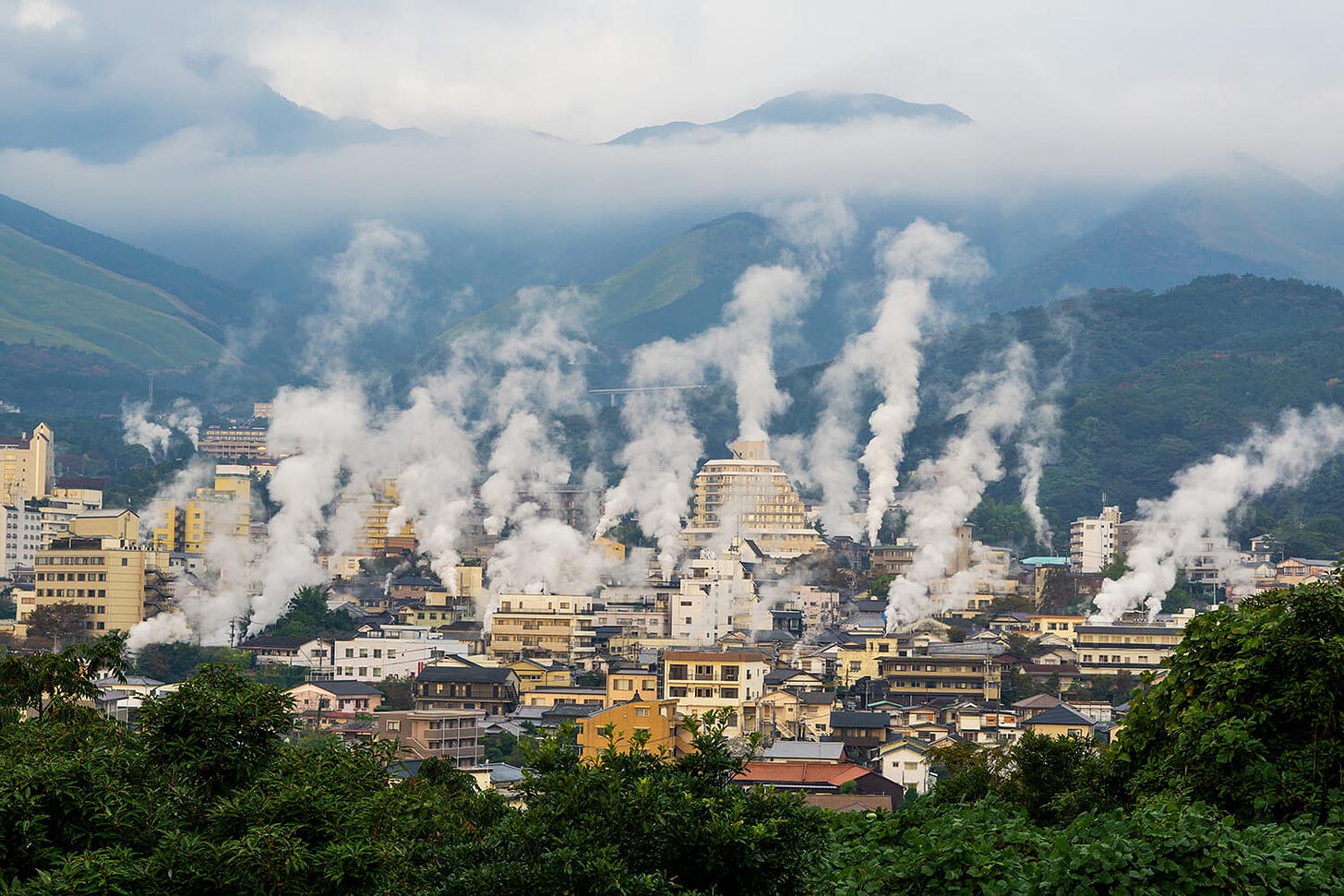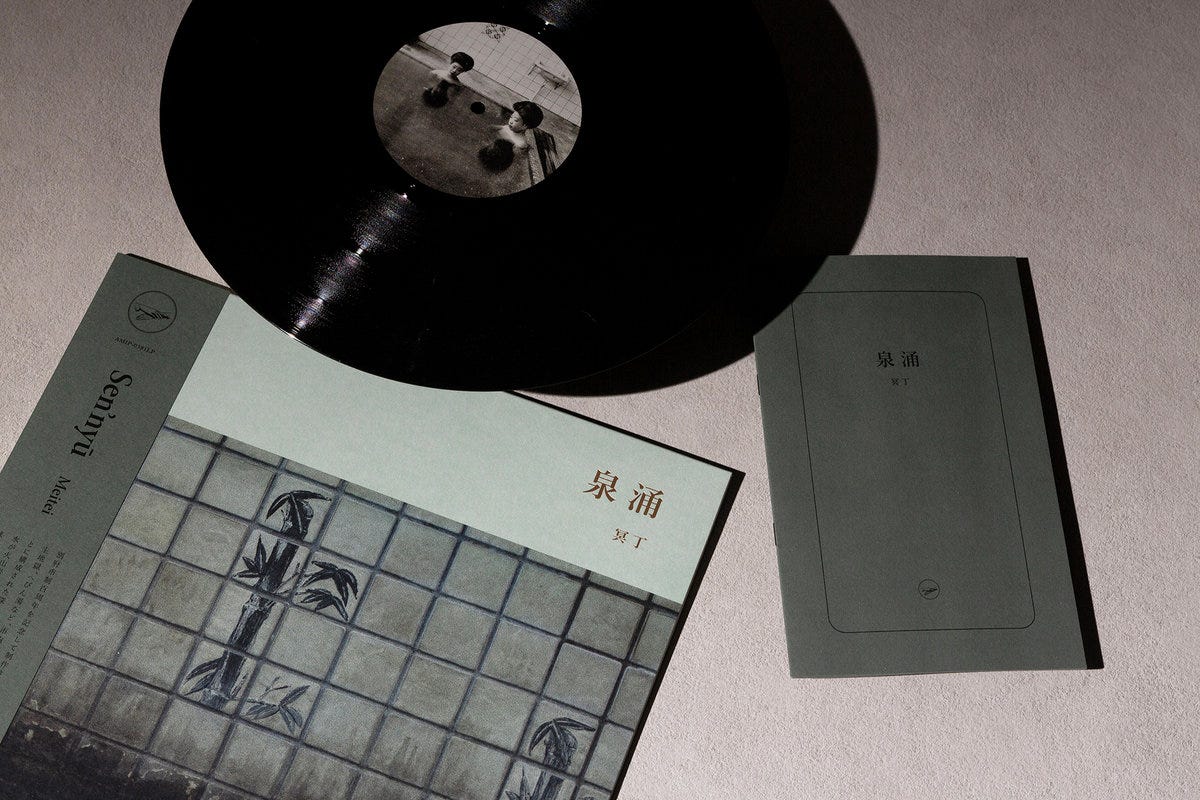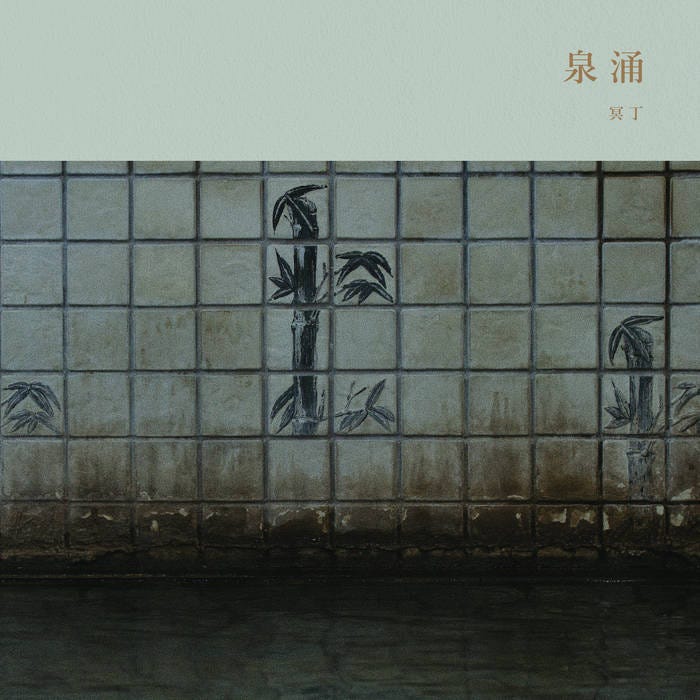REVIEW: Meitei - Sen’nyū
Fresh takes on timeless baths: Meitei's old-world vision meets the hot springs
47:31 // August 8th, 2025 // KITCHEN. LABEL
Meitei is our kind of gatekeeper: he uses his keen affinity for all that's precious and on the verge of vanishing from the world to offer the rest of us valuable insight before it goes. Praise be! He's earned acclaim and modest overseas publicity with his abstract interpretations of yesteryear's Japan, using sampled-based ambience to tackle everything from antique horror mythos to the sanitary plight of Edo-period sex workers; along the way, he's referenced a slew of cultural juggernauts from Akira Kurosawa to Jun'ichirō Tanizaki to Kawanabe Kyōsai, all with the overarching aim of recapturing what he calls the lost Japanese mood.
This wide-ranging set of snapshots can be heard over his trilogy of Kwaidan (2018), Komachi (2019) and Kofū (2020), the latter of which spawned two sequels and comprises its own trilogy-within-a-trilogy — but it's important to note that all three take a fatalistic approach to their subject matter (i.e. write it off as lost or disappearing, and do what they can to conserve an impression from the remnants). In many cases, they give their content a startling new life: Kofū’s vibrant tributes to Meiji-era entertainers and undisclosed women's narratives practically quiver in rebellion against the antiquated confines of their samples, while Komachi offers a deep reverie with or without its cultural background. Though Meitei's platform is unapologetically foreignised, he plays on the disjuncture between past and present to curate a vividly textured impression of subject matter that would otherwise risk scanning as academic; in those earlier albums, history sprouts like weeds between the cracks of modern sampling gear.
His new record Sen’nyū is a departure in this regard — though no less emphatically Japanese or proudly old-world than its predecessors (even the numeric kanji in the track titles are archaic), it engages with a culture that is very much alive and perhaps more familiar to overseas audiences: public bathing. Sen’nyū is not so much a tribute to Japan's renowned onsen (hot springs) as much as a direct imprint of them: the star attraction here is a set of tapes Meitei procured on a two-week visit to Beppu, a Kyushu town renowned for its umpteen onsen. These are the central feature of the entire album, so much so that it is more accurate to view it as a curated set of field recordings complemented by ambient instrumentals than the reverse. Meitei's air-quotes musical contributions never compete for the spotlight, and as one would hope for a worthy piece of kankyō ongaku (environmental music), his exploration of the onsen sound-world makes for a far more texturally distinctive outing than your common-or-garden flowing water-augmented ambient. As the album's press release tells it:
Equipped with a microphone, [Meitei] wandered Beppu’s sacred sites: Takegawara Onsen, Bouzu Jigoku, Hebin-yu, and the private baths of Yamada Bessou. There, he captured the breath of the springs, bubbling mud, hissing vents, wind against bamboo, and the murmurs of daily visitors. These field recordings became the sonic bedrock of Sen’nyū, an act of deep listening that attempts to render even the rising mist and shifting heat into sound.And so it goes — never less than steeped in the bathhouse, the album's five full tracks and one miniature trickle, gurgle, splutter and, in the memorable instance of "Sen’nyū - Yon-no-yu" (track #4), boil their way through one sluicing meditation after another, each tapping into a different facet of the bathing experience. The slowest soak comes early on: focused entirely on a steady trickle and accompanied by a minimum of ambient accents, "Sen’nyū - Ichi-no-yu" (track #1) is an uncompromising start that demands thorough immersion, and the first half of the following "Sen’nyū Ni-no-yu" (track #2) maintains this contemplative focus up until a midway bustle of guests changing baths. These tracks suggest the most isolated, attention-starved dimensions of a wash; they admittedly make for the least immediately appealing stretch of the album, but they certainly set a tone from which one can better appreciate the more sensuous soundscapes ("Sen’nyū"s San (track #3) and Go (track #6)) and bubbling textures ("Sen’nyū Yon-no-yu" (track #4)) that unfold later.

This all makes for a vitalising wash-out for anyone with a healthy attention span, but the specifics of its setting benefit from deeper unpacking. Much as Kwaidan's unsettling voiceovers rendered its horror inescapably focal, the prominence of Sen’nyū's field recordings frankly prohibits approaching it as anything other than an index of the onsen — but this does not necessarily make it an entirely situational listen. In an otherwise insightful unpacking of Sen'nyu, the Quietus' Archie Forde claims that the album is best listened to while lazing in the bath, a scene I can't help but see for its redundancy in much the same fashion as playing birdsong in an aviary, piping pre-recorded seascapes through a cruise ship, or blasting the audio from porno tapes as a bedroom chaser (thoughts and preferences in the comments, please).
Though I'm sure it would be pleasant enough to self-soundtrack one's bath this way, I'm reluctant to call Sen’nyū a bathing album at all. This is in part because the term undersells both the steamy confines of your bathroom (which should come readymade with its own aesthetics and atmosphere), and the album's uncanny ability to evoke bathhouse tranquillity in settings where such a thing is normally impossible. Kankyō ongaku has always leaned into using the sound-world of one setting to complement another, be it an art gallery, a hospital, or, per its ascent in the booming '80s, a forward-thinking retail space.
Above all, however, the bath-sounds-for-bathroomsperspective risks overlooking the singular aesthetics of the onsen and Japanese aesthetics more generally. The enclosed confines of the Western-style bathroom are a world apart from the pastoral bliss of the onsen, and not just because they lack bamboo fringes and rocky landscaping. As the anthropologist Fosco Maraini put it in his account of early post-war Japan,
In the west, after nearly two thousand years of opposition from the various churches, the bath was reduced, not long before the present age, to its mere hygienic or medical function [...] and it was used as a cure for certain affections. [...] Nowadays the bath has resumed importance in our lives, but as a barely tolerated concession, a challenge to deep emotional attitudes. It is surrounded with bolts and locks and glazed windows, and is only too often hidden in the least sunny and attractive room in the house. Bathrooms are still designed on the assumption that you enter them with your clothes and keep them on, taking them off only for the brief time necessary for immersing yourself in a tiled or metal coffin in which you simmer for a few minutes in a brew of your own dirt.
In Japan, however, the ultimate origins of the bath are religious. The bath is a domestic aspect of ancient purifactory rites (yuami, misogi) which from the earliest times were an essential element of the Shinto cult. Now, in the last analysis, every expression of religious feeling is a joyful thing; when a man feels, however indirectly and remotely from his conscious [sic], that he is in harmony with God, with the gods, the invisible, he is happy, at peace with himself and with others.
Fosco Maraini - Meeting With Japan (1959; pp.24-25)Even if our emotional attitudes have shifted since Mariani's time, then the role of bathrooms in interior design remains much the same. One sees further sensitivity and aversion to this Western association of cleanliness with scoured white surfaces in Tanizaki's famous essay on Japanese aesthetics: writing with respect to Western-style toilets (though in a spirit that can be applied just as readily to the bathroom), Tanizaki notes that
There is no denying the cleanliness; every nook and corner is pure white. Yet what need is there to remind us so forcefully of the issue of our own bodies. A beautiful woman, no matter how lovely her skin, would be considered indecent were she to show her bare buttocks or feet in the presence of others; and how very crude and tasteless to expose the toilet to such excessive illumination. The cleanliness of what can be seen only calls up the more clearly thoughts of what cannot be seen. In such places the distinction between the clean and the unclean is best left obscure, shrouded in a dusky haze.
Jun'ichirō Tanizaki - In Praise of Shadows (trans. Thomas Harper and Edward Seidensticker 1977(1933); p.5)Whatever one's opinion on the tastefulness of displaying buttocks or feet in company, Tanizaki's observations correlate with a key tenet of the onsen: that they leave no room for preciousness or self-consciousness here, whether in hygienic purism about shared bathwater or simple jitters at displaying one's own nudity in front of silent strangers.
Although it's hardly something one actively looks forward to, I think this communal dimension is one of the main reasons the springs are so cleansing: they are precisely the place where one should feel most comfortable in one's skin, and there's something oddly affirming in being surrounded by fellow bathgoers who are minding their own business doing precisely that — but don't stare! One feels none of the dissociative trappings of a Western bathroom (which I value too, for their own reasons), and this sense is particularly easy to intuit en plein air, where nudity is just another facet of the wind, rocks, bamboo and springwater that collectively fold into a wider reconnection with nature (turn to "Sen’nyū San-no-yu" (track #3) for the best on-record encapsulation of this).
However, the impact of onsen's public element is as significant in indoor baths — and so it is that the bathers themselves are highlighted in "Sen’nyū"s Ni and Go (tracks #2 and #5), the former as an overwhelming hubbub that supersedes all other sounds, the latter as a peripheral accent amidst the album's most introspective soundscape, blending the comings and goings of strangers into a deeper reverie. This communal focus is also apparent in the album's epimusical material:


If all of this inadvertently scans as a long promotional spiel for the merits of the onsen, then I couldn't be less sorry; those baths are magical and have transcended every attempt I've seen to mythologise them, from Spirited Away all the way to time-travelling Romans. Go to Japan and bathe. Free your pores and spirit! Be healthy and live forever, or else use the transient parameters of a hot dip to embrace your own mortality. Do it, or read about it, or watch brain-erasing romantic dramas about it — and then, when you've tapped into the same cleansing, tranquil goodness that immediately explains why the onsen have persisted so prominently for so long, consider how Sen’nyū's appeal goes far beyond quiet contemplation, how its wafting synths and gentle flutes assert decisively Japanese aesthetics over the underlying soundscape, how Meitei's emphasis on the continuity of time (marked most obviously by the sustained flow of water) documents an experience with such a strong foothold in the world as we know it that the most evocative interpretation can be as literal as it is here.
It's an exciting new approach for an artist whose style once saw centuries of history colliding with present-day associations and reborn in an ultra-vivid, time-freezing collage, but unlike those earlier outings, Meitei spends enough time in these bathscapes that they begin to feel like home. We hear Sen’nyū'sall-embracing near-constant trickle differently from track to track, as it waxes impassive, calming, stifling, and - eventually - soothing in turn, and I've caught enough echoes of a proper onsen bliss-out here to have given the album far more revisits than I initially anticipated. As such, it makes for a perfectly tenable introduction to the onsen for anyone not yet acquainted, and if it demands a little patience and some past-time jettisoning of any latent anti-spa misgivings, then no matter — no amount of cultural specificity can make a good bath anything less than a good bath.
8/10
Further listening:
gimme homework, show me kankyō ongaku base camp -> Hiroshi Yoshimura – Wet Land
just cleanse me again -> Takashi Kokubo – Oasis of the Wind II
&again but from 2025 please -> Yumiko Morioka & Takashi Kokubo – Gaiaphilia
the exact feeling of flushed skin against cool air that one feels on leaving an onsen -> Susumu Yokota – Grinning Cat 



First of all, super fun piece to read, even though digesting it over the past week during lunch breaks at work filled me with a torturous longing for my former local onsen in Nagano.
the album is a lot more accessible than it first appears, esoteric as it is. It will take a few more listens to fully soak in (lulz) but I'm liking it a lot so far and have queued up some of the recs as well.
And finally, big +1 to the exhortation to visit an onsen. I hate tapping into that "Westerners just don't understand" pretentiousness when describing aspects of Japan to others, but that's a big one. You really can't describe how transformative it is with words and I consider it one of the most essential components of a trip to Japan. Nine years out from my last footsteps on Japanese soil that's probably what I miss the most aside from anything to do with food.